Corporal Thomas Friday Keahanui Hema
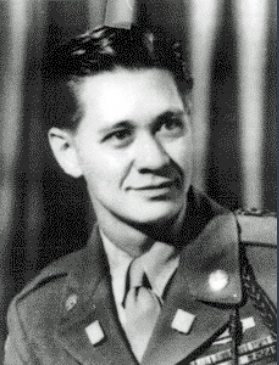
- Unit: 5th Regimental Combat Team, 2nd Battalion, Company G
- Service Number: 30111046
- Date of Birth: March 11, 1921
- Entered the Military: August 15, 1945
- Date of Death: September 4, 1950
- Hometown: Honolulu, Hawaiʻi
- Place of Death: Chingong-ni, Korea
- Award(s): Bronze Star, Purple Heart
- Cemetery: Plot Q, Grave 1353. National Memorial Cemetery of the Pacific, Honolulu, Hawaii
Mililani High School
2017-2018
Early Life
Friday Keahanui Hema was born in 1921. The native Hawaiian grew up in the Kapahulu neighborhood on the island of Oahu. He was the fourth of nine children born to David Keahonui Hema and Victoria Kapahukula Abigail Ernestberg. Known as “Tommy” his whole life, his friends nicknamed him Red for his sun bleached hair and love of the outdoors. Hema is remembered as being a true Hawaiian, a gentle, kind, and soft-spoken person who loved to laugh. A lover of Hawaiian food, he savored his fish and ate his poi with two fingers.
Growing up in Waikiki
With the revival of Hawaiian watersports in the early twentieth century, beach boys appeared in Waikiki as part of the developing tourist industry. In the 1930s, his father David Hema worked as a Waikiki beach boy, guarding the stretch of beach from the seawall along Kalakaua Avenue to the Elk’s Club, including the World War I Natatorium Memorial. Waikiki beach boys revived the traditional Hawaiian watersports of surfboarding and outrigger canoe surfing. Tommy and cousin, Albert “Rabbit” Kekai, grew up learning traditional Hawaiian watersports from Tommy’s father and surfing legends such as Duke Kahanamoku. Tommy learned his Hawaiian culture and the basics “aloha” on the sands of Waikiki Beach.
Education and Occupation
At age 16, Tommy left school and worked as a lumber yard truck driver for E.E. Black Construction. During this time, he moved in with his grandmother, Nellie Conrad, on Campbell Avenue. However, after several years of labor, the waterman chose to work as a Waikiki beach boy, teaching tourists to surf and taking them out in canoes.
Living Under Martial Law
On December 7, 1941, the Japanese bombed the island of Oahu. It is likely that Tommy watched as the bombs were dropped. After the smoke cleared, daily routines for all Honolulu residents changed. They lived under martial law, adhering to curfews and blackouts. One evening Tommy was out with friends, including his future wife, Sarah Estelle Kahunahana, after curfew. Tommy hid Sarah in the bushes so she would not be caught. Tommy and his friends went to court and paid a fine for breaking curfew.
The Renaissance era of surfing that started with his father’s generation ended after the bombing. Barbed wire fences and military patrols replaced the tourists and beach boys on Waikiki Beach. World War II slowed tourism. Many beach boys took other jobs or joined the military. Tommy returned to work at E.E. Black Construction.
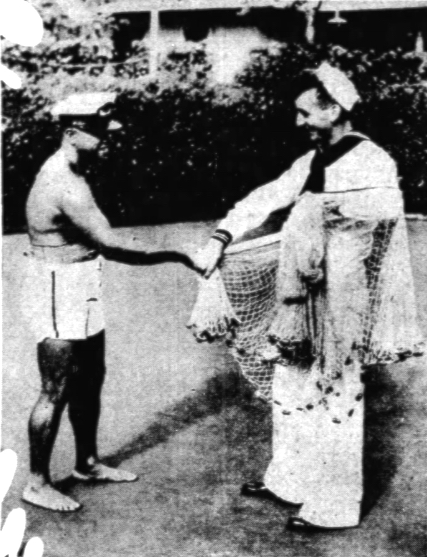
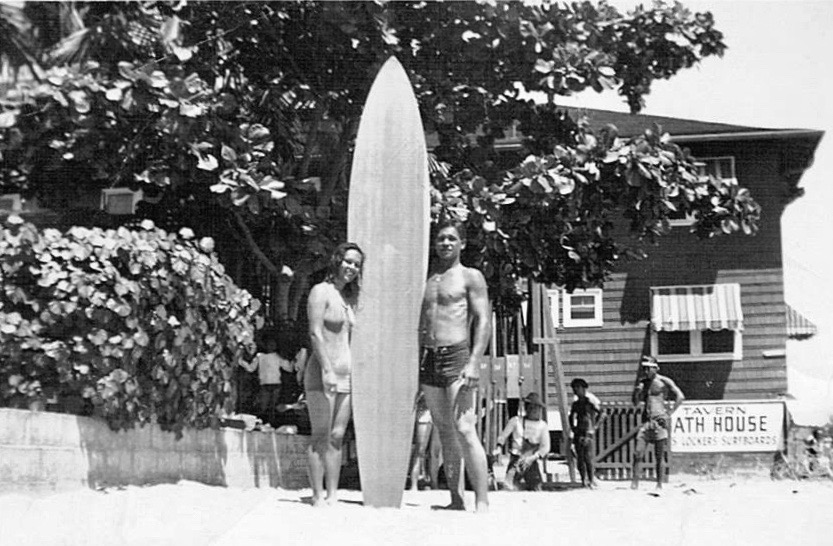
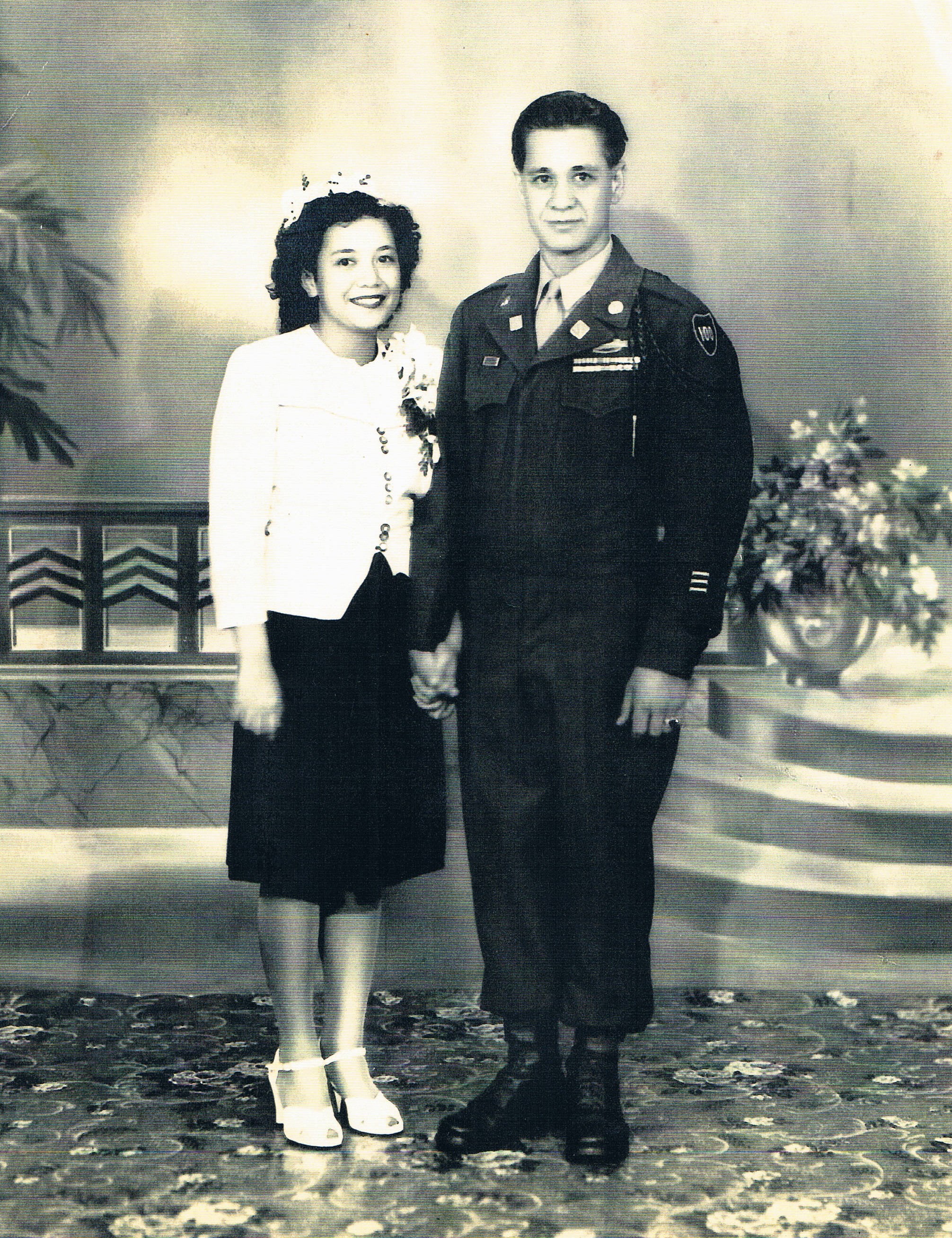
Military Experience
399th Infantry Regiment, 100th (Century) Division
Hema entered the U.S. Army on August 15, 1944, and completed basic training in Texas. In February 1945, Hema arrived in France to join Company A of the 100th Infantry Division, 399th Infantry Regiment. The division was positioned south of Bitche as part of the Seventh Army during the Battle of the Bulge. On March 15, the attack began and by the next day, the 100th Infantry Division controlled Bitche.
On that day, Hema and three other infantryman left covered positions to eliminate two hostile tanks. Advancing under fire to within 25 yards of one tank, they delivered effective cover which allowed an officer to disable the tank with rocket fire. A phosphorus grenade was tossed through a portal of the tank. As the hostile crew attempted to escape, four Germans were killed and the others taken prisoner. Hema received a Bronze Star for his bravery.
Hema’s battalion responded to a brutal attack on New Year’s Eve, assisted in the clearing of the Saarland Pocket, and captured Heilbronn after a bitter, nine-day battle.
Family Man
In December 1945, Hema re-enlisted on his way home for occupation service. He married Estelle and their first child, Victoria (know by her Hawaiian name, Nahale) was born later that year. Pearle and Thomas soon followed. Hema fashioned toys for his children, converting old skateboards into cars for Nahale, Pearl, and Tommy. He built their beds, a see-saw, and end tables. Hema settled into family life well, and Estelle felt they fit just fine. Everyday when he came home from work he hung his green cap and tended the best yard in the neighborhood. In his free time he enjoyed fishing, football, and attending boxing matches and stock car races.
51st Quartermaster Corps, 25th Infantry Division, Fort Kamehameha
While stationed in Hawaii in the late 1940s, Hema was attached to the Headquarters Company of the 51st Quartermaster Depot. He served at Fort Kamehameha and later at Fort Shafter. One day while driving an Army gasoline tanker truck on Kamehameha Highway, Hema narrowly escaped disaster when the truck caught fire. Hema lept from the flames in front of the Waipio Pineapple Stand. Not deterred, he re-enlisted again in December 1948.
Deploying to Korea
At the outbreak of the Korean War, the 5th Regimental Combat Team, nicknamed the Hawaiian Regiment, was hastily assembled. On July 12, 1950, the 5th Regimental Combat Team received orders to deploy. In a short time, they deployed on the USS General Hugh J. Gaffey on July 21, 1950. On July 31, 1950, the 5th Regimental Combat Team reached Pusan, Korea and prepared to join the fight, assigned to the 25th Infantry Division as part of Task Force Kean. According to Lieutenant General Walton H. Walker, the defense of Pusan was a “Stand or Die” situation.
On August 2, the 2nd Battalion of the 5th Regimental Combat Team moved to the front line at Chindon-ni under fire. Hema’s Company G was attacked by North Koreans while holding Hill 342 (Fox Hill). They initially lost control of the Hill, but later regained it. During a week of savage fighting, Task Force Kean met and defeated the North Korean 6th Division. On August 7, Task Force Kean dissolved and the 5th Regimental Combat Team was reassigned to the 1st Cavalry Division.
Battle of Battle Mountain
Hema’s unit faced daily fire at the Battle of Battle Mountain. On August 13, the 2nd Battalion engaged in a heavy firefight with the enemy near Tae-Dong. The 5th Regimental Combat Team was to take control of Hill 665, or “Battle Mountain,” which was occupied by the North Koreans. Control of the Sobuk-Sans peaks was crucial to the defense of Pusan. After taking the mountain, the battalion faced continued attack from the North Koreans, and control of this land changed hands repeatedly.
In a letter home, Hema wrote only 68 men from his company survived. In his letter’s return address, he indicated a field promotion to sergeant. According to a fellow soldier, Hema was assigned to a heavy weapons squad.
The Great Naktong Offensive
On September 1, 1950, the North Koreans launched their last major attempt to overwhelm the Pusan Perimeter, the Great Naktong Offensive. North Koreans launched simultaneous human wave attacks, which the 5th Regimental Combat Team called “banzai” attacks. The 2nd Battalion held ground from Chinju to the Chingdong-ni Road.
On September 2, Companies F and G of the 2nd Battalion drove the enemy back and killed a large percentage of the enemy force. The North Koreans counter attacked on September 3, driving Company G from its positions on the highest ground. Another counter attack restored the lost position.
Hema’s Final Stand
By September 4, the situation was dire. The fighting was intense and both sides were overextended. Near dawn on September 4, the North Koreans renewed their attacks on Company G and again penetrated their position. By evening, small arms fire and grenades continued to be directed against Company G’s positions. Corporal Hema was killed by a bullet to the chest while defending his position on “George Hill” near Chingong-ni, South Korea.
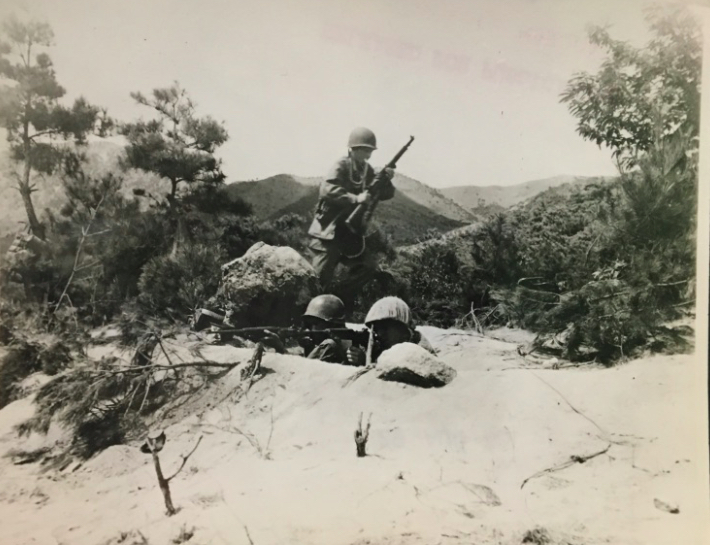
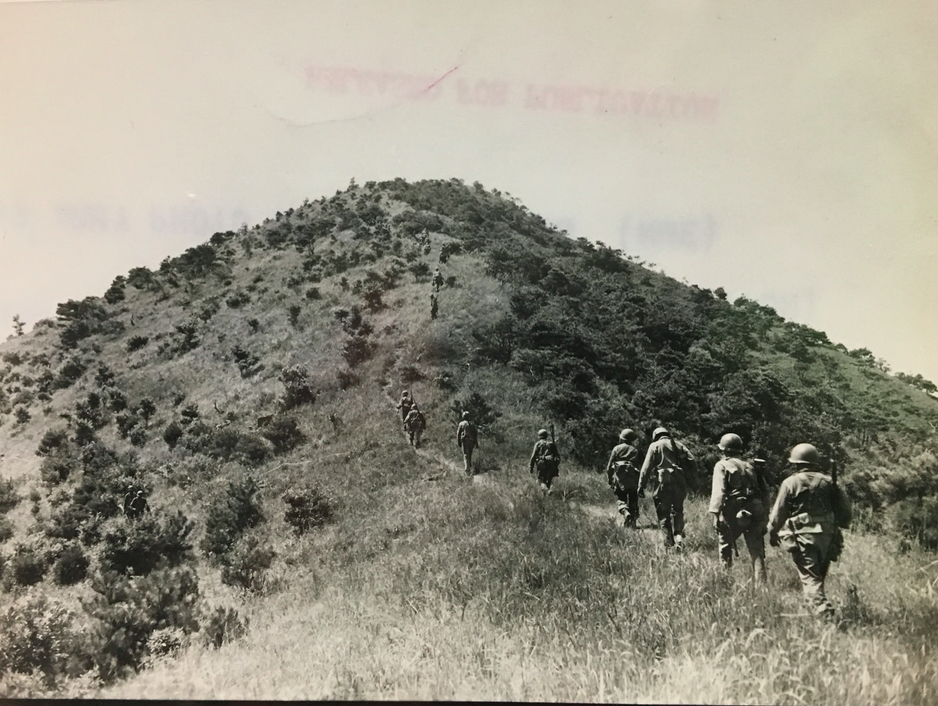
Eulogy
In letters to close friends just before he died, Hema longed to be home with family and friends. He expressed his thanks to them for caring for his family and confessed he had tears in his eyes.
Hema never met his daughter Susan, born while he was in Korea. Corporal Hema’s wife, Sarah, always told her four children she wished their dad lived so they could see how kind and wonderful he was. His son Tommy often thought about how different their lives might have been. Instead Hema fought bravely so that others could live in a free world.
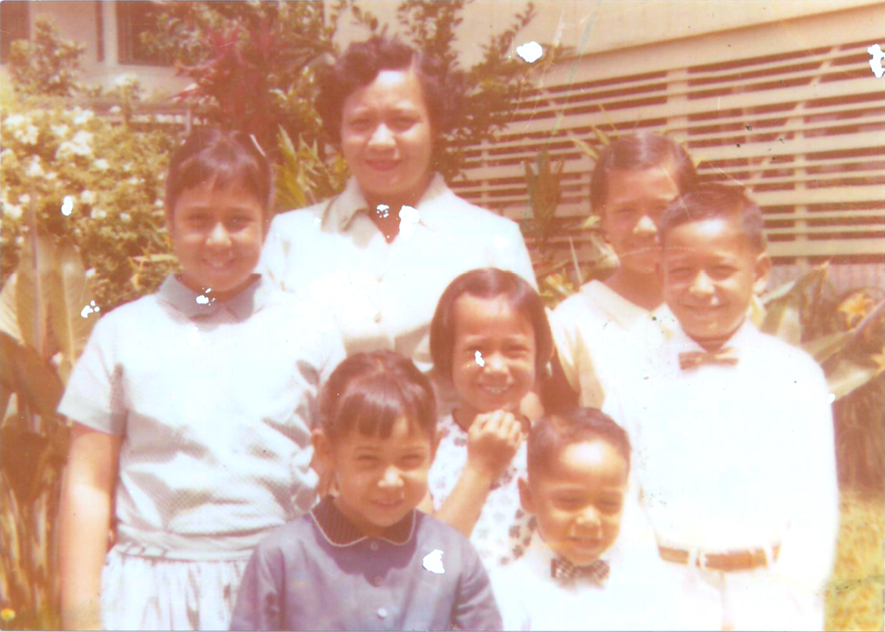
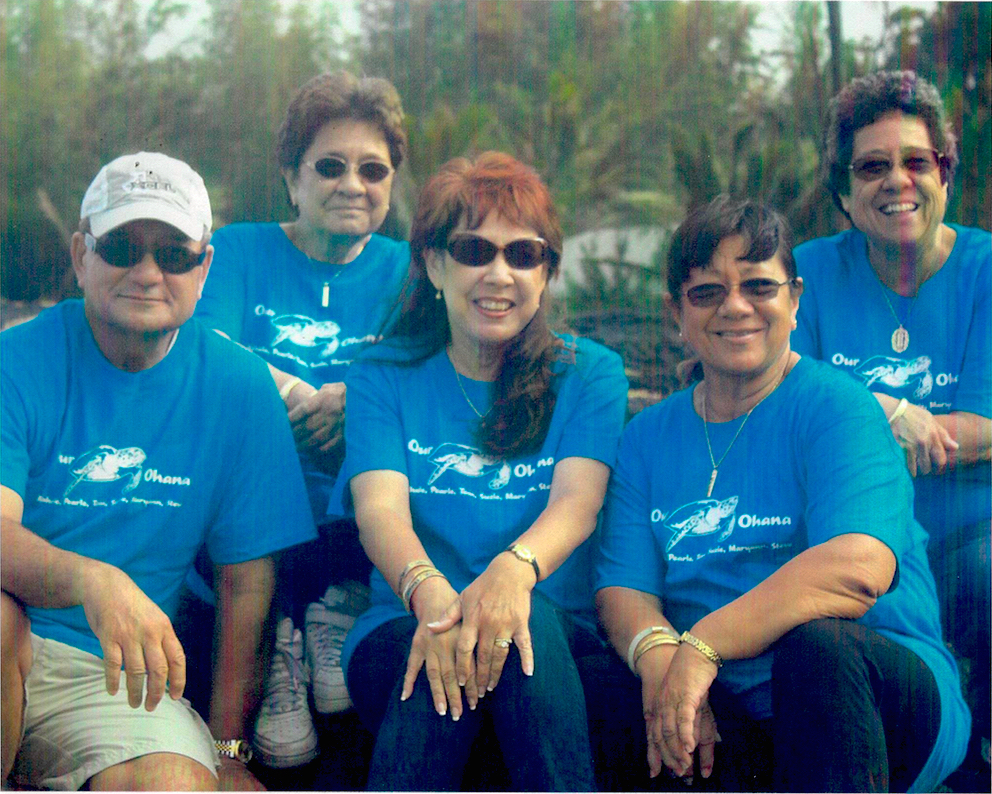
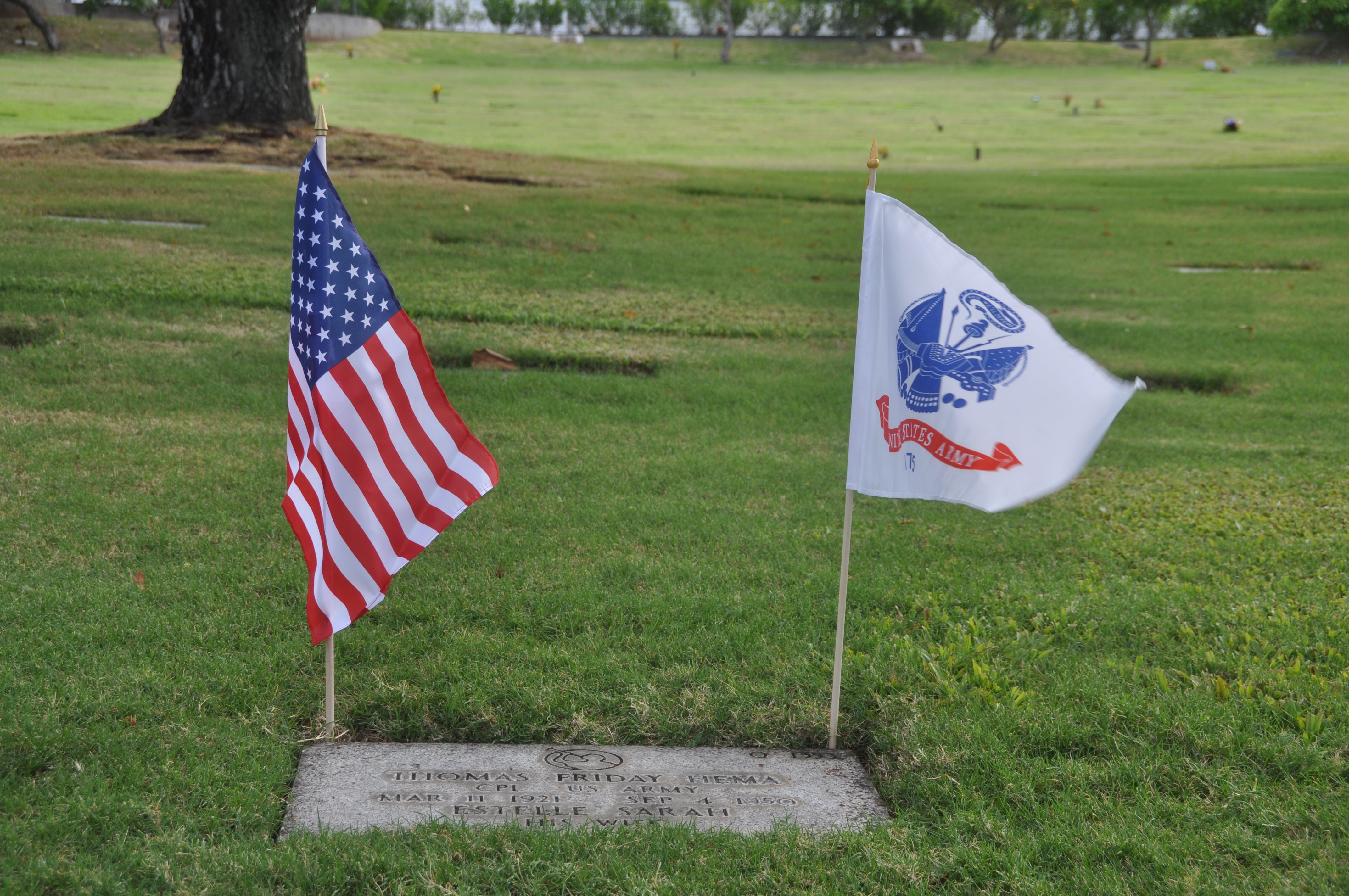
Reflection
Bibliography
399th in Action: With the 100th Infantry Division. Bedford: Aegis Consulting Group, Inc, 1946. Accessed July 5, 2018. www.marshallfoundation.org/100th-infantry/399th-infantry-regiment/.
Bruner, D. W., R. J. Butler, and A. D. Holmes. Able in Combat: Co. A 399th Inf. Rgt. 100th Division. The Regiment, 1945.
Chang, SFC Al. Infantrymen of 5th RCT move up Chuk Chon mountain. Photograph. August 30,1950. National Archives and Records Administration (347662). Image.
Chang, SFC Al. Infantrymen of 5th RCT return fire on Sobuk mountain. Photograph. August 29, 1950. National Archives and Records Administration (377135). Image.
“David Hema.” Honolulu Star Bulletin. March 6, 1979, 27. Newspapers.com (271904862).
“Drivers Flee Uninjured At Waikakalaua.” Honolulu Advertiser. August 25, 1948, 11. Newspapers.com (18156310).
Friday Keahanui Hema. Report no. 151 1921 – 006981. Certification of Live Birth. Honolulu: State of Hawaii, 1921.
Gault-Williams, Malcolm. “Rabbit Kekai (1920-2016).” Surfing Heritage & Culture Center. Last modified May 14, 2016. Accessed July 1, 2018. www.legendarysurfers.com/2016/05/.
Hawaii. Honolulu County. 1930 U.S. Census. Digital Images. ancestry.com.
Hawaii. Honolulu County. 1940 U.S. Census. Digital Images. ancestry.com.
Hema Family Photographs. 1946-1950. Courtesy of Hema Family.
“Hema-Kahunahana Marriages Notice.” Honolulu Star Bulletin. March 21, 1946, 18. Newspapers.com (297956991).
Hema, Thomas. E-mail interview by the author. July 9, 2018.
Kakesako, Gregg K. “Hawaii vets revisit ‘the Forgotten War.'” Star Bulletin. Last modified July 25, 2000. Accessed May 28, 2018. archives.starbulletin.com/2000/07/25/news/story5.html.
Longacre, Edward G. “Heilbronn: One Last Place to Die.” America in WWII Magazine, April 2010, 27-35. Accessed July 5, 2018. www.americainwwii.com/pdfs/stories/heilbronn-one-last-place-to-die.pdf.
“Marriages.” Honolulu Star Bulletin. March 21, 1946, 18. Newspapers.com (19711798).
“Miss Fixit Answers.” Honolulu Advertiser. August 30, 1946, 16. Newspapers.com (21459622).
“Miss Kahunahana is Bride-Elect.” Honolulu Advertiser. January 21, 1945, 14. Newspapers.com (259219356).
“News of Hawaii Boys In Service.” Honolulu Star Bulletin. July 12, 1945, 2. Newspapers.com (275596911).
Otaguro, Susan Lilinoe Hema. E-mail interview by the author. May 30, 2018.
Records for Thomas F. Hema; Korean War Casualty File, 1950-1953 [Electronic File], Record Group 407; National Archives at College Park, College Park, MD [retrieved from the Access to Archival Databases at aad.archives.gov/aad/, July 5, 2018].
Records for Thomas F. Hema; World War II Army Enlistment Records, 1938-1946 [Electronic File], Record Group 64; National Archives at College Park, College Park, MD [retrieved from the Access to Archival Databases at aad.archives.gov/aad/series-description.jsp?s=3360&cat=WR26&bc=,sl, July 5, 2018].
Rhee, President Syngman. South Korean Presidential Unit Citation for 5th RCT. Seoul, South Korea: Tropic Lightning Museum Archive, 1953.
Scheiber, Jane L., and Harry N. Scheiber. “Martial Law in Hawaii.” Densho Encyclopedia. Last modified July 29, 2015. Accessed July 5, 2015. encyclopedia.densho.org/Martial_law_in_Hawaii/.
Schimitt, Robert, Ed. “Waikiki Beach Boys.” Hawaiian Historical Society. Accessed July 5, 2018. www.hawaiihistory.org/index.cfm?t=1&fuseaction=ig.page&pageid=394&PageLayout=Print.
“Seek Larger Crew at Pool.” Honolulu Star Bulletin February 4, 1930, 10. Newspapers.com (19711687).
“Silver Star to Oahu Officers; 3 GIs Killed.” Honolulu Advertiser. September 28, 1950, 1, 8. Newspapers.com (19710127).
“Six Hawaiians Plan to Re-enlist.” Honolulu Advertiser. January 31, 1946, 5. Newspapers.com (259335191).
Slater, Michael P. Hills of Sacrifice: The 5th RCT in Korea. Honolulu: Turner Publishing, 2000.
Something New for the Sailor to do. February 4, 1933. Photograph. Newspapers.com (18156933).
Thomas Hema, Individual Deceased Personnel File, Department of the Army.
Thomas Hema, Official Military Personnel File, Department of the Army, RG 319, National Archives and Records Administration – St. Louis.
“Thomas F. Hema” Nationwide Gravesite Locator. Accessed August 29, 2018. gravelocator.cem.va.gov/index.html.
Thomas F. Hema. U.S. National Cemetery Interment Control Forms, 1928-1962. Digital Images. ancestry.com.
Thomas F. Hema to John & Jenny Alanano. August 25, 1950. Courtesy of the Hema Family.
“Thomas Friday Hema: Korean War Casualty from Hawaii.” HonorStates.org. Accessed May 18, 2018. www.honorstates.org/index.php?id=163562.
Toth, Catherine E. “How Waikiki’s Legendary Beach Boys Defined Aloha.” Hawai’i Magazine, June 8, 2018. Accessed July 1, 2018. www.hawaiimagazine.com/content/how-waikikis-legendary-beach-boys-defined-aloha.
U.S. WWII Draft Cards Young Men, 1940-1947; Records of the Army Air Forces, World War II Combat Operations Report 1941-1946, Record Group 18 (Box 2964); National Archives at College Park, College Park, MD.
Waikiki Lifeguard David Hema. February 4, 1933. Photograph. Honolulu Star-Bulletin Archive.
Waikiki Beach After Bombing 1941. December 1941. Photograph. Bishop Museum, Honolulu, HI.
Willie, Waikiki. “Not Easy to be a Beach Boy; It’s Life Occupation.” Honolulu Star Bulletin. January 28, 1939, 10. Newspapers.com (21593648).
WWI, WWII, and Korean War Casualty Listings. American Battle Monuments Commission. Digital Images. ancestry.com.
Young, Sgt. Clarence. “Schofield Barracks, July 1950.” Interview. In Baldovi, Louis, Ed. A Foxhole View: Personal Accounts of Hawaii’s Korean War Veterans. Honolulu: University of Hawai’i Press, 2002.

